Dental Implants
Transform your smile at Solea Dental with our exceptional Dental Implants service. Our expert team specializes in classic, all-on-4, and all-on-6 implants, utilizing high-quality zirconium and titanium materials. Restore your confidence with precise and long-lasting tooth replacements.
Experience personalized care and cutting-edge technology for optimal results. Say goodbye to missing teeth and hello to a beautiful, functional smile. Visit us today for a consultation - take the first step towards a brighter future!

The cost of dental implants varies from $2,000 to $4,000 per tooth. Replacing all of your teeth can range from $30,000 to $50,000, depending on your specific situation and bone condition.
| Procedure | Cost |
|---|---|
| All-on-4 implantation | start at $17999 |
| All-on-6 implantation | start at $19999 |
Financing programs 0%
Don't postpone creating a beautiful smile - do it today in installments, at 0% interest.

Care Credit

Invisalign Financing
What implants do we use at Solea Dental?
Advantages of the clinic
Our doctors are experienced professionals, motivated to use their expertise to help you maintain oral health.
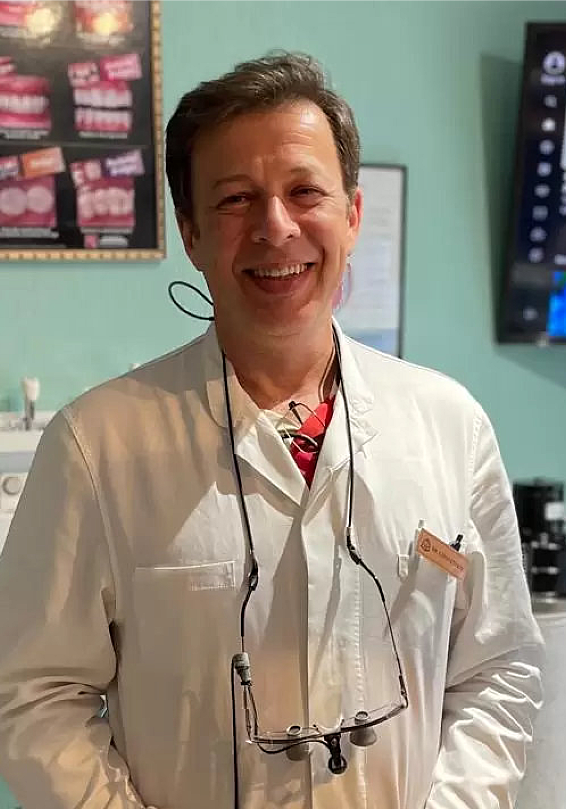
Dr. B. Lipovetskiy
- Over 31 years of experience
"My goal is to thoroughly study each individual clinical case in order to determine the safest treatment plan for the patient, without the use of unnecessary chemicals or uncomfortable tools. I practice the use of biocompatible (non-toxic) and tested materials, as well as advanced technologies (such as laser treatment). I prefer using simple terms to explain each stage of the treatment to patients. This relieves tension and eliminates many questions. My patients always understand each step of the procedure, and feel confident entrusting their health to the professionals at Solea Dental."
![]()
The benefits of implantation
With the help of dental implant technology, you can regain confidence in your smile and no longer struggle with impaired speech or chewing capabilities. Some of the benefits of dental implants include:
- Restoring full chewing ability
- Preventing bone loss
- Stabilizing adjacent teeth
- Guarding against gum disease
Dental implants are virtually indistinguishable from your natural teeth, providing a realistic look and feel that results in a stunning smile!
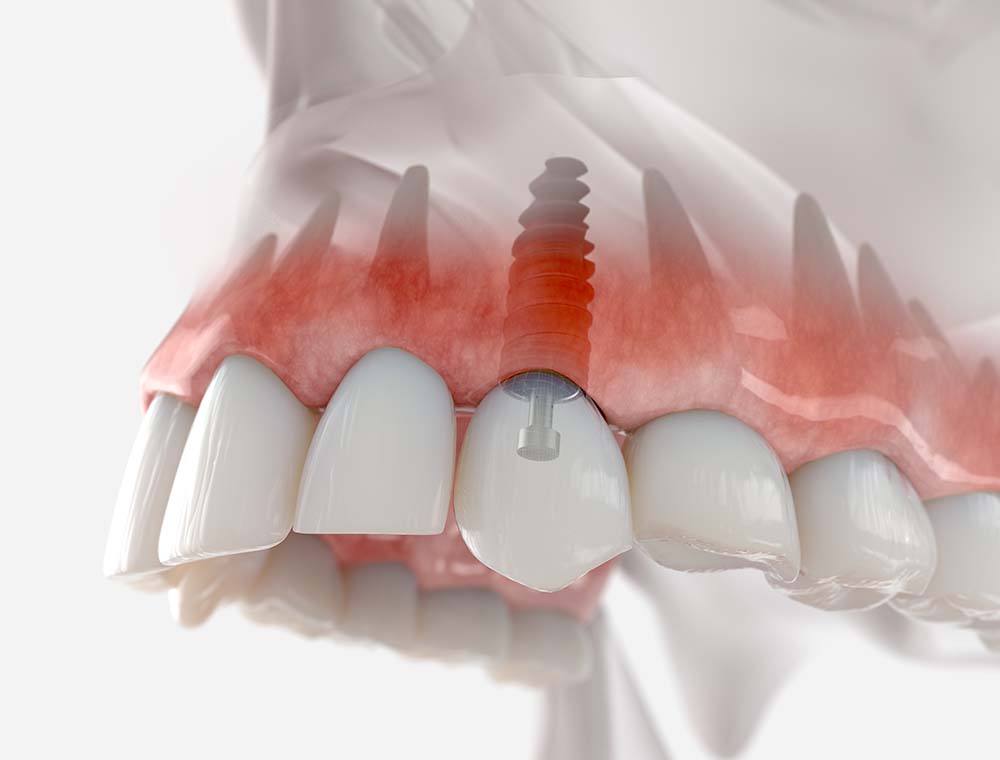
Indications
If you are missing a single tooth, we can install an implant. If it's a front tooth and temporary crown placement is not possible, we offer a temporary immediate denture.
If you are missing two or three adjacent teeth, you can opt for a bridge prosthesis or have crowns supported by implants. The first option involves grinding down healthy teeth and removing the nerves. When prosthetic work is done on implants, this is not necessary, so we recommend it specifically.
If you are missing all teeth in your jaw, the most popular option for full tooth replacement is the All-on-4/All-on-6 technique. This technology allows you to achieve results in just 1 day. All-on-4: Two implants are placed where the front teeth used to be, and the remaining two are attached on the sides (in the molar region) at an angle. This ensures secure fixation of the implants even without bone grafting.
Contraindications
- Relative
- Presence of a granuloma or cyst
- Viral infections
- Dental calculus (tartar)
- Tooth decay
- Breastfeeding
- Malocclusion
- Pregnancy
- Insufficient jawbone volume
- Absolute
- Autoimmune diseases
- HIV/AIDS
- Malignant tumors
- Tuberculosis
- Mental disorders
- Chronic alcoholism or drug addiction
Stages of implantation
Patient examination and diagnosis
The standard examination includes a panoramic X-ray and, in some cases, a computed tomography (cbcs cat scan) scan (for full implantation). The X-ray allows the doctor to determine the thickness of the bone layer, proximity to anatomical structures, and identify contraindications for the surgery.
Treatment planning
Treatment planning is done using a specialized computer program based on jaw tomographic scans. The program allows for precise selection of implant parameters, their positioning in the bone, and the creation of a temporary prosthetic structure.
Oral cavity preparation
Before the implantation procedure, it is necessary to treat acute infectious diseases of the oral cavity, eliminate sources of infection (such as cavities, inflammatory processes in the gums and roots), and perform professional oral hygiene.
Surgical implant placement
On the scheduled day, a surgical procedure is performed to implant the artificial roots. The operation is done under general anesthesia and typically takes between 30 minutes to 2 hours.
The surgical phase varies depending on the chosen technique:
- Classical implantation: An implant with a cover screw is placed, and sutures are applied. The sutures are removed after 7 days.
- One-stage implantation: An implant with a gingival former is placed, and within 1-7 days, a temporary crown or fixed prosthesis is placed on temporary abutments.
- Immediate implantation: A broken tooth is removed, and an implant is immediately placed in its position. Immediate implant placement can be performed using either a one-stage or classical two-stage technique.
Permanent prosthesis
After 3-6 months, a follow-up X-ray of the jaw is taken. If the osseointegration of the artificial roots is successful, impressions are taken for the permanent prosthesis. After 7 days, a permanent restoration made of ceramic composite, metal-ceramic, or zirconia is placed on permanent abutments for the patient.
Implantation methods
Classical
Each missing tooth is replaced with a titanium or circonium implant. A minimum of 8 implants is placed in one jaw. The classical method of restoring a toothless jaw is preferred for patients but requires an adequate amount of bone.
To avoid extensive bone grafting in cases of severe bone atrophy, alternative methods of full implantation are used.
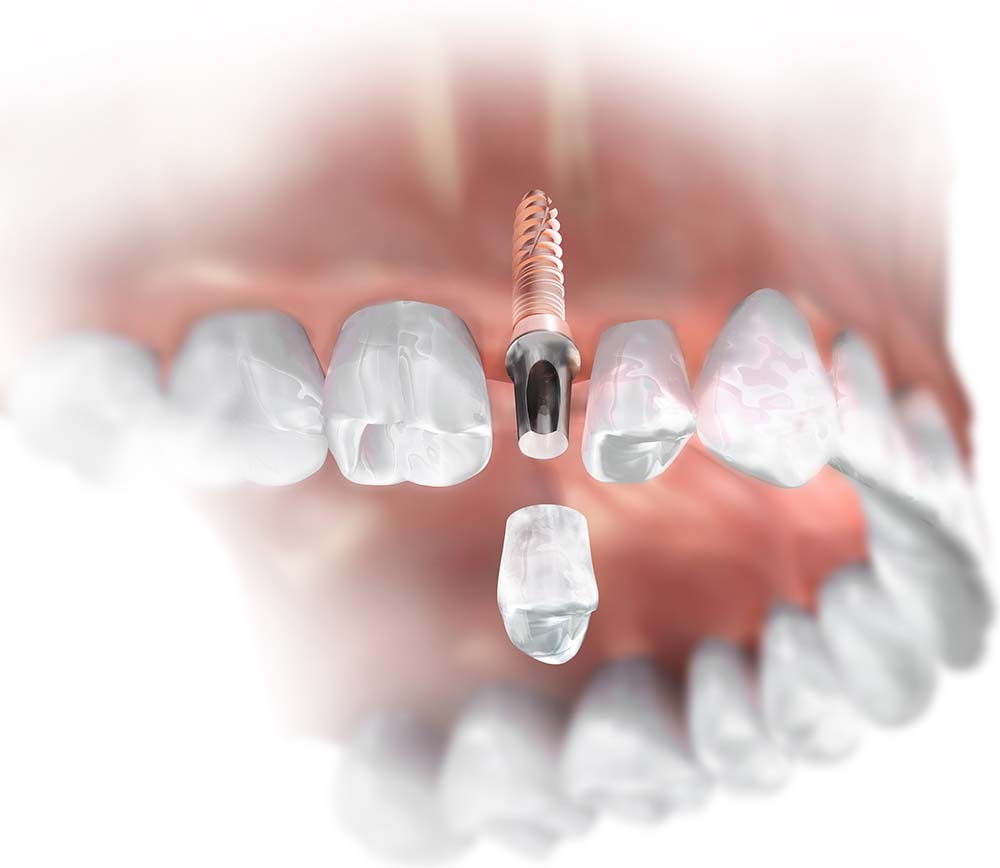
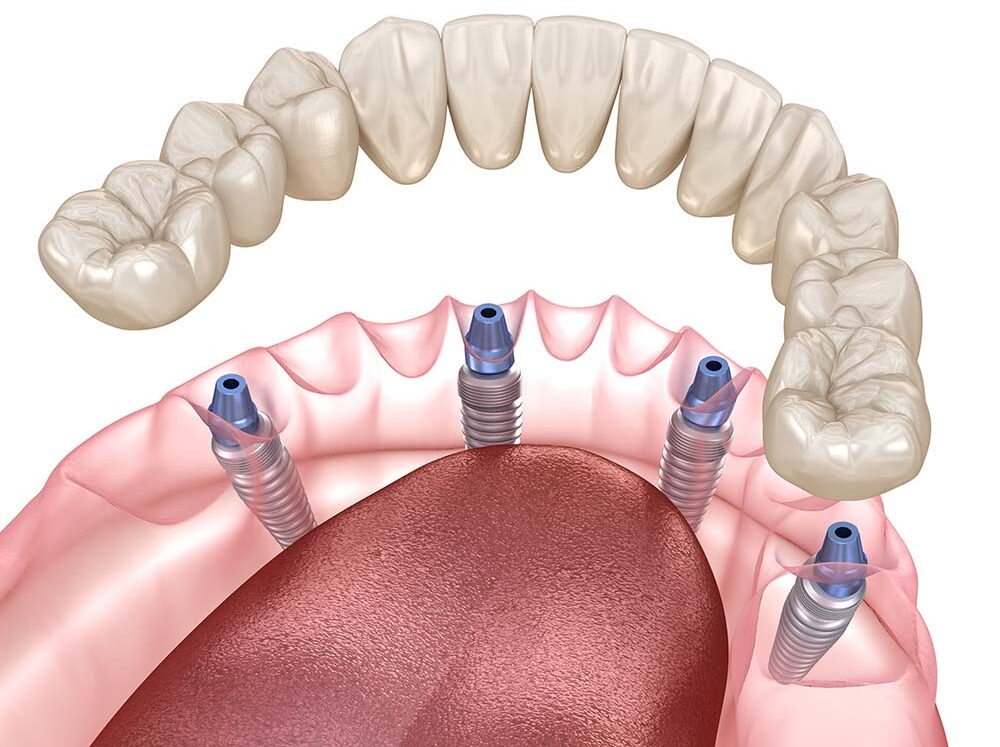
All-on-4
An alternative protocol developed by Nobel Biocare for restoring a toothless jaw with insufficient amounts of bone tissue. According to the technology, support for a full fixed prosthesis is provided by 4 titanium rods, 2 of which are implanted at an angle in the distal (lateral) regions of the jaw, and the other 2 in the frontal region. The method involves immediate loading of the implants on the day of the surgery.
The method is recommended for elderly people or patients with a limited treatment budget.
All-on-6
The principle of implant placement in the All-on-6 technology is identical to All-on-4. Two additional posts are added to the system to increase the stability of the structure.
This method is recommended for young patients with a wide jaw and is preferable for the upper jaw, where the bone is more loose.
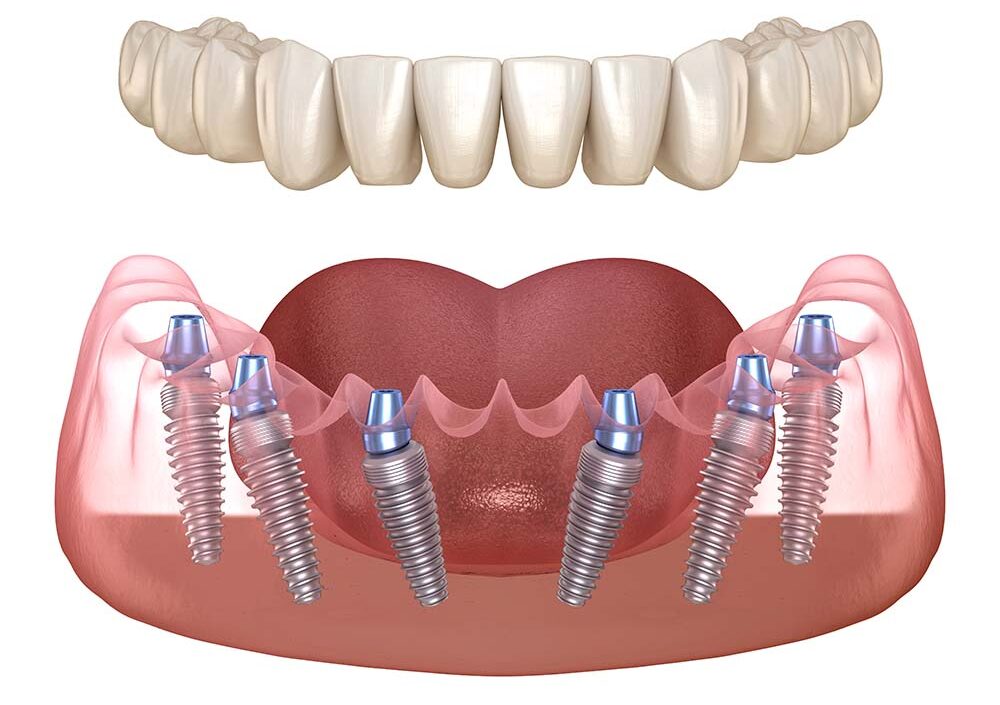
Q&A
Mild pain may follow the initial dental implant procedure due to the required gum incision and jawbone drilling. The procedure is performed under local anesthesia, ensuring minimal discomfort or pain during the operation.
Post-procedure pain can typically be managed with over-the-counter pain relievers, but consult your doctor if you require further assistance.
There is a minimum probability of 1% of the implant failing. Several factors can contribute to implant failure, including poor oral hygiene, inadequate bone quality or quantity, infection, smoking, uncontrolled diabetes, autoimmune disorders, and certain medications. Implant failure may result in pain, mobility, or even loss of the implant.
To maximize the success of dental implants, it is important to follow proper oral hygiene practices, maintain overall health, and consult with a qualified dental professional for proper evaluation, planning, and implant placement.
Bone augmentation, also known as bone grafting, is a dental procedure that involves adding or replacing bone tissue in the jaw or other areas of the body. It is commonly performed to create a solid foundation for dental implants by increasing bone volume or repairing bone defects caused by trauma, periodontal disease, or tooth extraction.
During the procedure, bone graft materials, such as synthetic grafts, autografts (taken from the patient's own body), or allografts (from a donor), are placed in the targeted area. Over time, the graft material fuses with the existing bone, promoting new bone growth and providing structural support. Bone augmentation enhances the success rate of dental implant placement and restores the ability to chew, speak, and smile confidently.
Get Dental Implants Today!
Dental implants can enhance the appearance of your smile. What can dental implants do for me? Call us today for a consultation.

